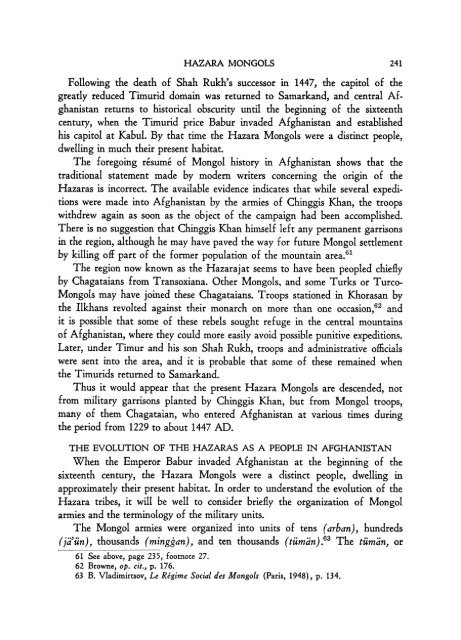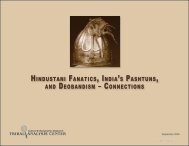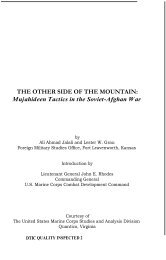the inquiry into the hazara mongols of afghanistan - Tribal Analysis ...
the inquiry into the hazara mongols of afghanistan - Tribal Analysis ...
the inquiry into the hazara mongols of afghanistan - Tribal Analysis ...
Create successful ePaper yourself
Turn your PDF publications into a flip-book with our unique Google optimized e-Paper software.
HAZARA MONGOLS 241Following <strong>the</strong> death <strong>of</strong> Shah Rukh's successor in 1447, <strong>the</strong> capitol <strong>of</strong> <strong>the</strong>greatly reduced Timurid domain was returned to Samarkand, and central Afghanistanreturns to historical obscurity until <strong>the</strong> beginning <strong>of</strong> <strong>the</strong> sixteenthcentury, when <strong>the</strong> Timurid price Babur invaded Afghanistan and establishedhis capitol at Kabul. By that time <strong>the</strong> Hazara Mongols were a distinct people,dwelling in much <strong>the</strong>ir present habitat.The foregoing resume <strong>of</strong> Mongol history in Afghanistan shows that <strong>the</strong>traditional statement made by modern writers concerning <strong>the</strong> origin <strong>of</strong> <strong>the</strong>Hazaras is incorrect. The available evidence indicates that while several expeditionswere made <strong>into</strong> Afghanistan by <strong>the</strong> armies <strong>of</strong> Chinggis Khan, <strong>the</strong> troopswithdrew again as soon as <strong>the</strong> object <strong>of</strong> <strong>the</strong> campaign had been accomplished.There is no suggestion that Chinggis Khan himself left any permanent garrisonsin <strong>the</strong> region, although he may have paved <strong>the</strong> way for future Mongol settlementby killing <strong>of</strong>f part <strong>of</strong> <strong>the</strong> former population <strong>of</strong> <strong>the</strong> mountain area.1The region now known as <strong>the</strong> Hazarajat seems to have been peopled chieflyby Chagataians from Transoxiana. O<strong>the</strong>r Mongols, and some Turks or Turco-Mongols may have joined <strong>the</strong>se Chagataians. Troops stationed in Khorasan by<strong>the</strong> Ilkhans revolted against <strong>the</strong>ir monarch on more than one occasion,2 andit is possible that some <strong>of</strong> <strong>the</strong>se rebels sought refuge in <strong>the</strong> central mountains<strong>of</strong> Afghanistan, where <strong>the</strong>y could more easily avoid possible punitive expeditions.Later, under Timur and his son Shah Rukh, troops and administrative <strong>of</strong>ficialswere sent <strong>into</strong> <strong>the</strong> area, and it is probable that some <strong>of</strong> <strong>the</strong>se remained when<strong>the</strong> Timurids returned to Samarkand.Thus it would appear that <strong>the</strong> present Hazara Mongols are descended, notfrom military garrisons planted by Chinggis Khan, but from Mongol troops,many <strong>of</strong> <strong>the</strong>m Chagataian, who entered Afghanistan at various times during<strong>the</strong> period from 1229 to about 1447 AD.THE EVOLUTION OF THE HAZARAS AS A PEOPLE IN AFGHANISTANWhen <strong>the</strong> Emperor Babur invaded Afghanistan at <strong>the</strong> beginning <strong>of</strong> <strong>the</strong>sixteenth century, <strong>the</strong> Hazara Mongols were a distinct people, dwelling inapproximately <strong>the</strong>ir present habitat. In order to understand <strong>the</strong> evolution <strong>of</strong> <strong>the</strong>Hazara tribes, it will be well to consider briefly <strong>the</strong> organization <strong>of</strong> Mongolarmies and <strong>the</strong> terminology <strong>of</strong> <strong>the</strong> military units.The Mongol armies were organized <strong>into</strong> units <strong>of</strong> tens (arban), hundreds(ja'iin), thousands (minggan), and ten thousands (tiiman).3 The tiiman, or61 See above, page 235, footnote 27.62 Browne, op. cit., p. 176.63 B. Vladimirtsov, Le Regime Social des Mongols (Paris, 1948), p. 134.
















